Understanding the Sustainable Mechanisms of Poverty Alleviation Resettlement in China’s Developed Regions under the Background of Land Relocation: Drivers, Paths and Outcomes
Abstract
1. Introduction
2. Literature Review
2.1. Why Does PAR Occur within Developed Regions?
2.2. The Effects of PAR
3. Methodology
3.1. Case Study
3.2. Data and Methods
4. Results and Discussion
4.1. The Drivers of Developed Regions’ PAR
4.2. The Paths of Developed Regions’ PAR
4.3. The Outcomes of Developed Regions’ PAR
- (1)
- Direct outcomes
- (2)
- Spillover effects
4.4. The Mechanism of Developed Regions’ PAR
5. Conclusions
Author Contributions
Funding
Informed Consent Statement
Data Availability Statement
Conflicts of Interest
Appendix A
- (1)
- For government officials
- (2)
- For the plan-maker of Qingyuan’s 2019 resettlement planning
| 1 | The data above was derived from the semi-structured interviews, precisely i1. |
| 2 | See notes 1 above |
| 3 | See notes 1 above |
| 4 | See notes 1 above |
| 5 | The data above was derived from the semi-structured interviews, precisely i2. |
| 6 | See notes 5 above |
| 7 | The data above was derived from the semi-structured interviews, precisely i5. |
| 8 | See notes 5 above |
| 9 | See notes 1 above |
| 10 | See notes 5 above |
| 11 | See notes 7 above |
| 12 | See notes 7 above |
| 13 | The data above was derived from the semi-structured interviews, precisely i3. |
| 14 | See notes 7 above |
| 15 | The data above was derived from the semi-structured interviews, precisely i4. |
References
- Zhou, Y.; Guo, Y.; Liu, Y.; Wu, W.; Li, Y. Targeted poverty alleviation and land policy innovation: Some practice and policy implications from China. Land Use Policy 2018, 74, 53–65. [Google Scholar] [CrossRef]
- Zhang, D. Formulation and Implementation of “China Rural Poverty Alleviation and Development Program (2001–2010)”. In The Evolution of China’s Poverty Alleviation and Development Policy (2001–2015); Zuo, C., Ed.; Springer: Singapore, 2019; pp. 1–44. [Google Scholar]
- Liu, Y.; Fang, F.; Li, Y. Key issues of land use in China and implications for policy making. Land Use Policy 2014, 40, 6–12. [Google Scholar] [CrossRef]
- Yang, Y.; de Sherbinin, A.; Liu, Y. China’s poverty alleviation resettlement: Progress, problems and solutions. Habitat Int. 2020, 98, 102135. [Google Scholar] [CrossRef]
- Chen, R.; Ye, C.; Cai, Y.; Xing, X.; Chen, Q. The impact of rural out-migration on land use transition in China: Past, present and trend. Land Use Policy 2014, 40, 101–110. [Google Scholar] [CrossRef]
- Liu, W.; Xu, J.; Li, J.; Li, S. Rural Households’ Poverty and Relocation and Settlement: Evidence from Western China. Int. J. Environ. Res. Public Health 2019, 16, 2609. [Google Scholar] [CrossRef] [PubMed]
- Li, C.; Guo, M.; Li, S.; Feldman, M. The Impact of the Anti-Poverty Relocation and Settlement Program on Rural Households’ Well-Being and Ecosystem Dependence: Evidence from Western China. Soc. Nat. Resour. 2021, 34, 40–59. [Google Scholar] [CrossRef]
- Rogers, S.; Li, J.; Lo, K.; Guo, H.; Li, C. China’s rapidly evolving practice of poverty resettlement: Moving millions to eliminate poverty. Dev. Policy Rev. 2020, 38, 541–554. [Google Scholar] [CrossRef]
- Winkels, A.; Adger, W.N. Sustainable livelihoods and migration in Vietnam: The importance of social capital as access to resources. In Proceedings of the International Symposium on Sustaining Food Security and Managing Natural Resources in Southeast Asia—Challenges for the 21st Century, Chiang Mai, Thailand, 8–11 January 2002; pp. 1–15. [Google Scholar]
- Patel, S.; Sliuzas, R.; Mathur, N. The risk of impoverishment in urban development-induced displacement and resettlement in Ahmedabad. Environ. Urban. 2015, 27, 231–256. [Google Scholar] [CrossRef]
- Baird, I.G.; Shoemaker, B. Unsettling Experiences: Internal Resettlement and International Aid Agencies in Laos. Dev. Chang. 2007, 38, 865–888. [Google Scholar] [CrossRef]
- Zhou, Y.; Guo, L.; Liu, Y. Land consolidation boosting poverty alleviation in China: Theory and practice. Land Use Policy 2019, 82, 339–348. [Google Scholar] [CrossRef]
- Besley, T.; Burgess, R. Land reform, poverty reduction, and growth: Evidence from India. Q. J. Econ. 2000, 115, 389–430. [Google Scholar] [CrossRef]
- Zhao, S.; Li, W. The Dilemma and Countermeasures of Poverty Alleviation by Relocation in China: A Literature Review. Soc. Secur. Stud. 2018, S1, 106–112. [Google Scholar]
- Xu, Y.; Xiong, Y. Review on Relocation Aimed at Poverty Alleviation. J. Northwest A F Univ. (Soc. Sci. Ed.) 2018, 18, 107–114. [Google Scholar] [CrossRef]
- Wang, C. The Dilemma and Countermeasures of the Poverty Alleviation by Relocation. Hebei Acad. J. 2018, 38, 146–151. [Google Scholar]
- Gao, W.; Vries, W.; Zhao, Q. Understanding rural resettlement paths under the increasing versus decreasing balance land use policy in China. Land Use Policy 2021, 103, 105325. [Google Scholar] [CrossRef]
- Research Group of Wuhan University on Follow-Up Support for Relocation for PovertyAlleviation. The Basic Characteristics of Relocation for Poverty Alleviation and Path Selections of the Follow-Up Support. Chin. Rural Econ. 2020, S1, 88–102. [Google Scholar]
- Liu, W.; Li, J.; Xu, J. Impact of the ecological resettlement program in southern Shaanxi Province, China on households’ livelihood strategies. For. Policy Econ. 2020, 120, 102310. [Google Scholar] [CrossRef]
- Li, C.; Li, M. The Policy Information Gap and Resettlers’ Well-Being: Evidence from the Anti-Poverty Relocation and Resettlement Program in China. Int. J. Environ. Res. Public Health 2020, 17, 2957. [Google Scholar] [CrossRef]
- Tang, J.; Xu, Y.; Ma, W.; Gao, S. Does participation in poverty alleviation programmes increase subjective well-being? Results from a survey of rural residents in Shanxi, China. Habitat Int. 2021, 118, 102455. [Google Scholar] [CrossRef]
- Liu, W.; Radmehr, R.; Zhang, S.; Rastegari Henneberry, S.; Wei, C. Driving mechanism of concentrated rural resettlement in upland areas of Sichuan Basin: A perspective of marketing hierarchy transformation. Land Use Policy 2020, 99, 104879. [Google Scholar] [CrossRef]
- Ferraro, P.J.; Hanauer, M.M. Quantifying causal mechanisms to determine how protected areas affect poverty through changes in ecosystem services and infrastructure. Proc. Natl. Acad. Sci. USA 2014, 111, 4332–4337. [Google Scholar] [CrossRef]
- Xue, L.; Wang, M.Y.; Xue, T. ‘Voluntary’ Poverty Alleviation Resettlement in China. Dev. Chang. 2013, 44, 1159–1180. [Google Scholar] [CrossRef]
- Xu, H.; Pittock, J.; Daniell, K. ‘Sustainability of what, for whom? A critical analysis of Chinese development induced displacement and resettlement (DIDR) programs. Land Use Policy 2022, 115, 106043. [Google Scholar] [CrossRef]
- Harris, J.M. Basic Principles of Sustainable Development. Dimens. Sustain. Dev. 2000, S1, 21–41. [Google Scholar] [CrossRef]
- Rogers, S.; Wilmsen, B. Towards a critical geography of resettlement. Prog. Hum. Geogr. 2020, 44, 256–275. [Google Scholar] [CrossRef]
- Dickinson, D.; Webber Professor, M. Environmental resettlement and development, on the steppes of Inner Mongolia, PRC. J. Dev. Stud. 2007, 43, 537–561. [Google Scholar] [CrossRef]
- Rogers, S.; Wang, M. Environmental resettlement and social dis/re-articulation in Inner Mongolia, China. Popul. Environ. 2006, 28, 41–68. [Google Scholar] [CrossRef]
- Zhou, Y.; Liu, Y. The geography of poverty: Review and research prospects. J. Rural Stud. 2022, 93, 408–416. [Google Scholar] [CrossRef]
- Fan, M.; Li, Y.; Li, W. Solving one problem by creating a bigger one: The consequences of ecological resettlement for grassland restoration and poverty alleviation in Northwestern China. Land Use Policy 2015, 42, 124–130. [Google Scholar] [CrossRef]
- Kou, H. The PPE Cycle and China’s Sustainable Development. Teach. Ref. Middle Sch. Geogr. 2005, S1, 27–28. [Google Scholar]
- China Regional Economy 50-People Forum. Zhang Keyun: Uneven and Inadequate Regional Development and Regional Governance Innovation in the 14th Five-Year Plan Period. 2020. Available online: https://www.thepaper.cn/newsDetail_forward_10526613 (accessed on 13 February 2023).
- Chauhan, R.K.; Mohanty, S.K.; Subramanian, S.V.; Parida, J.K.; Padhi, B. Regional Estimates of Poverty and Inequality in India, 1993–2012. Soc. Indic. Res. 2016, 127, 1249–1296. [Google Scholar] [CrossRef]
- Brandolini, A.; Cipollone, P. Urban poverty in developed countries. In Inequality, Welfare and Poverty: Theory and Measurement; Bandyopadhyay, S., Rodríguez, J.G., Eds.; Research on Economic Inequality; Emerald Group Publishing Limited: Leeds, UK, 2003; Volume 9, pp. 309–343. [Google Scholar]
- Morazes, J.; Pintak, I. Theories of Global Poverty. J. Hum. Behav. Soc. Environ. 2007, 16, 105–121. [Google Scholar] [CrossRef]
- Bertolini, P. Overview of Income and Non-Income Rural Poverty in Developed Countries; United Nations Economic Commission for Africa: Addis Ababa, Ethiopia, 2019. [Google Scholar]
- Wang, C.; Wang, Y.; Fang, H.; Gao, B.; Weng, Z.; Tian, Y. Determinants of Rural Poverty in Remote Mountains of Southeast China from the Household Perspective. Soc. Indic. Res. 2020, 150, 793–810. [Google Scholar] [CrossRef]
- Gustafsson, B. How and Why Has Poverty in China Changed? A Study Based on Microdata for 1988 and 1995. China Q. 2000, 164, 983–1006. [Google Scholar] [CrossRef]
- Tang, J.; Gong, J.; Ma, W.; Rahut, D.B. Narrowing urban–rural income gap in China: The role of the targeted poverty alleviation program. Econ. Anal. Policy 2022, 75, 74–90. [Google Scholar] [CrossRef]
- Ni, H.; Huang, H.; Zhong, G.; Zheng, Q. Considerations on the models of poverty alleviation in Guangdong. Guangdong Agric. Sci. 2011, 38, 221–224. [Google Scholar] [CrossRef]
- Hou, X.; Wang, Y.; Xu, H.; Guo, Z. Study on the Spillover Effect and Feedback Mechanism of the Precision Poverty Reduction Strategy. J. Dalian Marit. Univ. (Soc. Sci. Ed.) 2020, 19, 78–83. [Google Scholar]
- Liu, Y.; Zhang, G. The linkage between poverty alleviation and rural revitalization: Spillover effects and path optimization. Rural Econ. 2022, S1, 59–66. [Google Scholar]
- The People’s Government of Qingyuan. Overview of Qingyuan. 2023. Available online: https://www.zjqy.gov.cn/art/2023/2/27/art_1229355934_58954088.html (accessed on 27 February 2023).
- The People’s Government of Qingyuan. Qingyuan’s Statistical Communique on the 2021 National Economic and Social Development. 2022. Available online: http://www.zjqy.gov.cn/art/2022/5/25/art_1229561532_4928825.html (accessed on 13 July 2023).
- Development and Reform Bureau of Qingyuan County. Qingyuan County 14th Five-Year Plan of Geological Disaster Prevention and Control. 2021. Available online: https://zjjcmspublic.oss-cn-hangzhou-zwynet-d01-a.internet.cloud.zj.gov.cn/jcms_files/jcms1/web3677/site/attach/0/1cd4a06bb0324269a934010a8aa39267.pdf (accessed on 23 February 2023).
- Department of Natural Resources and Planning of Qingyuan County. Change Survey of Land Use Situation of Qingyuan County. 2022. Available online: https://www.zjqy.gov.cn/art/2022/1/10/art_1229432649_4857755.html (accessed on 13 May 2023).
- Zhejiang Sets Example in Poverty Alleviation. 2020. Available online: http://www.ezhejiang.gov.cn/2020-10/13/c_543995.htm (accessed on 23 February 2023).
- National Bureau of Statistics. Income and Consumption Expenditure of the Population in 2021. 2022. Available online: http://www.stats.gov.cn/xxgk/sjfb/zxfb2020/202201/t20220117_1826442.html (accessed on 13 May 2023).
- The People’s Government of Qingyuan. County People’s Hospital Grows Steadily in Difficult Times. 2019. Available online: https://www.zjqy.gov.cn/art/2019/9/17/art_1229356029_58719129.html (accessed on 3 February 2023).
- The People’s Government of Qingyuan. 2003 Qingyuan Yearbook. 2004. Available online: http://www.zjqy.gov.cn/art/2004/11/24/art_1229355939_58772210.html (accessed on 13 February 2023).
- The People’s Government of Qingyuan. The Cadres’ General Assembly Was Held. 2008. Available online: http://www.zjqy.gov.cn/art/2008/2/19/art_1229356024_58742319.html (accessed on 13 February 2023).
- Zhejiang Daily. Lishui: “Resettlement and Management for Comprehensive Measure of Geological Disaster”. 2018. Available online: https://baijiahao.baidu.com/s?id=1619059855494659650&wfr=spider&fo (accessed on 13 July 2023).
- The People’s Government of Qingyuan. Practicing the “Eight-Eight Strategies” for 15 Years, Qingyuan Realized “Seven New Leaps”. 2018. Available online: https://www.zjqy.gov.cn/art/2018/8/31/art_1229356027_58727954.html (accessed on 13 May 2023).
- The People’s Government of Qingyuan. 2022 Qingyuan Yearbook. 2023. Available online: http://www.zjqy.gov.cn/art/2022/9/23/art_1229355939_58950434.html (accessed on 23 September 2023).
- Agricultural and Rural Affairs Bureau of Qingyuan County. The Implementation Plan of the ‘Resettlement and Agglomeration Project toward Prosperity and Livability’ in Qingyuan County (2019–2023). 2021. Available online: https://www.zjqy.gov.cn/art/2021/4/29/art_1229517185_58940091.html (accessed on 13 May 2023).
- Sun, X. High-level construction of the “four good rural roads” make a new chapter—A few thoughts of Zhejiang high-level construction of the “four good rural roads”. China Highw. 2018, S1, 102–103. [Google Scholar] [CrossRef]
- Agricultural and Rural Affairs Bureau of Qingyuan County. The Implementation Advice of the ‘Resettlement and Agglomeration Project toward Prosperity and Livability’ in Qingyuan County (2019–2023). 2021. Available online: https://www.zjqy.gov.cn/art/2021/4/29/art_1229517187_58940117.html (accessed on 13 February 2023).
- Chen, Y.; Tan, Y.; Mao, C. Mountain Hazards, Risk Management, Disaster-Preventive and Poverty-Alleviating Resettlement. Catastrophology 2013, 28, 7. [Google Scholar]
- Hong, X. A Brief Discussion on the Impact of Hangzhou Rural Highway Construction on the Rural Economy. Econ. Trade. 2017, S1, 45+47. [Google Scholar]
- Luo, Z.; Jiang, Z. Self-Built Housing Resettlement: Xing’an Innovates Five Models to Resettle Reservoir Migrants. Guangxi Daily, 19 November 2013; p. 005. [Google Scholar]
- The People’s Government of Zhengzhou. Zhengzhou Issued ‘House Ticket’ Resettlement Implementation Measures to Broaden the Resettlement Channels of Large Shantytown Transformation. 2022. Available online: https://www.henan.gov.cn/2022/06-21/2471935.html (accessed on 18 April 2023).
- National Development and Reform Commission. National 13th Five-Year Plan for PAR. 2017. Available online: https://www.ndrc.gov.cn/fggz/fzzlgh/gjjzxgh/201705/t20170516_1196764.html (accessed on 17 May 2023).
- The People’s Government of Qingyuan. Hundred Days of Fighting to Tackle the Project Every Second to Strive for Progress. 2020. Available online: http://www.zjqy.gov.cn/art/2020/5/7/art_1229356027_58737999.html (accessed on 18 April 2023).
- Agricultural and Rural Bureau of Qingyuan County. Sixteen Opinions of the CPC Qingyuan County People’s Government on the High-Quality Promotion of the Rural Revitalization Strategy to Ensure the Comprehensive Completion of a Well-Off Society at a High Level in Synchronization with the Entire Province. 2021. Available online: http://www.zjqy.gov.cn/art/2021/8/23/art_1229517187_58942655.html (accessed on 18 April 2023).
- The People’s Government of Lishui City. Qingyuan Agricultural Transfer Population Realizes “Re-Employment” Close to Home. 2022. Available online: http://www.lishui.gov.cn/art/2022/12/7/art_1229218391_57341446.html (accessed on 7 December 2022).
- Zhejiang Statistical Bureau. Zhejiang Provincial Statistical Yearbook in 2022. 2023. Available online: https://tjj.zj.gov.cn/col/col1525563/index.html (accessed on 23 June 2023).
- National Bureau of Statistics. China Statistical Yearbook in 2021. 2022. Available online: https://www.stats.gov.cn/sj/ndsj/2021/indexch.htm (accessed on 13 June 2023).
- The State Council Information Office. Suggestions on Comprehensively Deepening Rural Reform and Accelerating Agricultural Modernization. 2014. Available online: http://www.scio.gov.cn/ztk/xwfb/2014/gxbjhgsncywjybxtjdfmqk/xgzc30414/Document/1363120/1363120.htm (accessed on 10 September 2023).
- Xie, Z.; Li, Y. The Linkage Policy with Chinese Characteristics: Course, Effect and Prospect. Fisc. Sci. 2022, S1, 10–28. [Google Scholar] [CrossRef]
- The State Council. Suggestions of the State Council on Preventing the Tendency of ‘Non-Grain Production’ of Arable Land. 2020. Available online: http://www.gov.cn/zhengce/content/2020-11/17/content_5562053.htm (accessed on 23 September 2023).
- The People’s Government of Qingyuan. The Transfer of Land Contract Rights and Management Rights Activates the Capital of Rich Farmers. 2019. Available online: http://www.zjqy.gov.cn/art/2019/9/17/art_1229356029_58713494.html (accessed on 12 August 2023).
- The People’s Government of Qingyuan. County to Promote “Five Models” of Rural Land Transfer. 2019. Available online: http://www.zjqy.gov.cn/art/2019/9/17/art_1229356029_58727188.html (accessed on 12 August 2023).
- Zhejiang Statistical Bureau. Zhejiang Provincial Statistical Yearbook in 2021. 2022. Available online: https://tjj.zj.gov.cn/col/col1525563/index.html (accessed on 23 June 2023).
- Clancy, P. Arctic Power: The Path to Responsible Government in Canada’s North. Polar Rec. 1997, 33, 349–350. [Google Scholar] [CrossRef][Green Version]

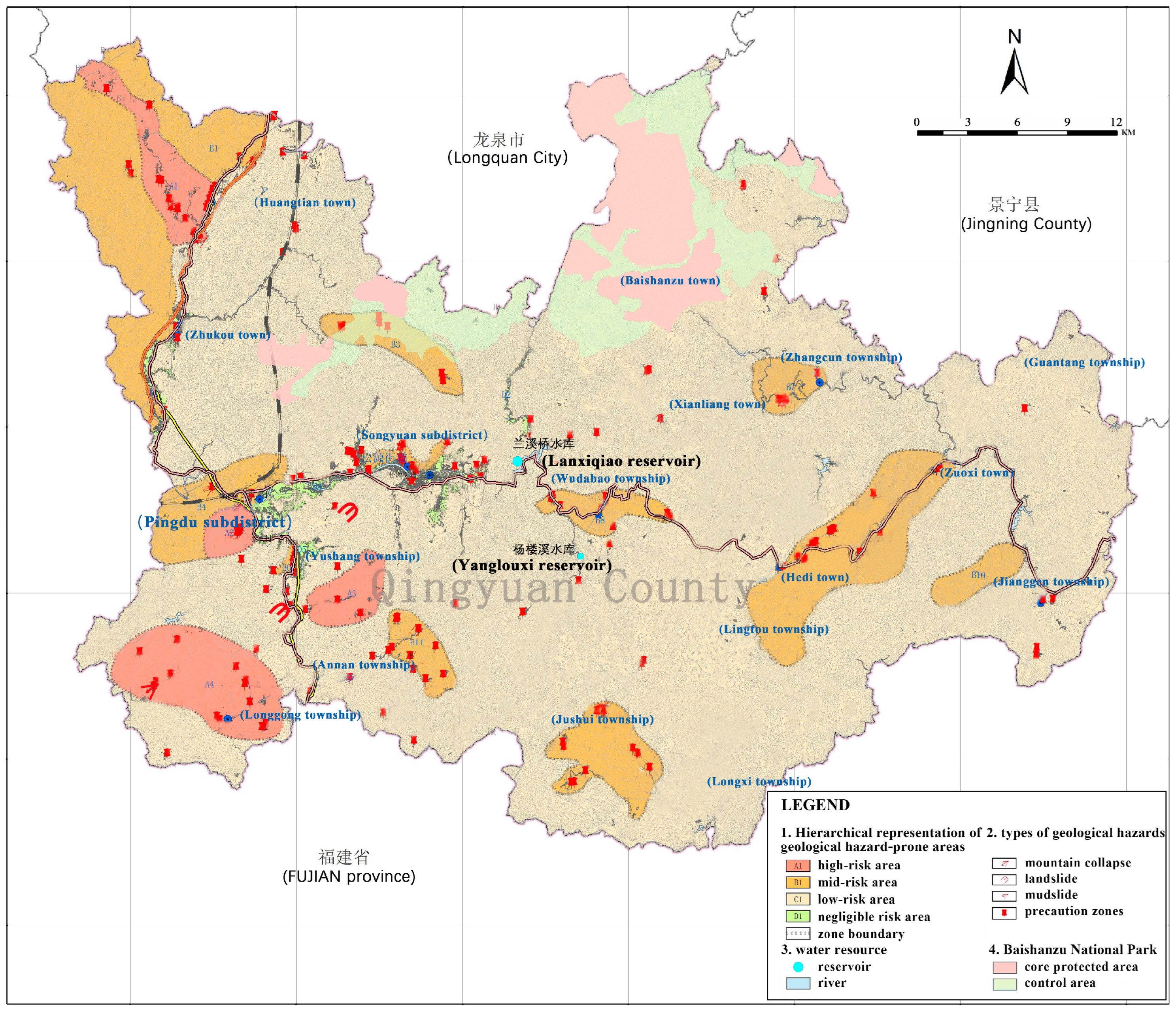

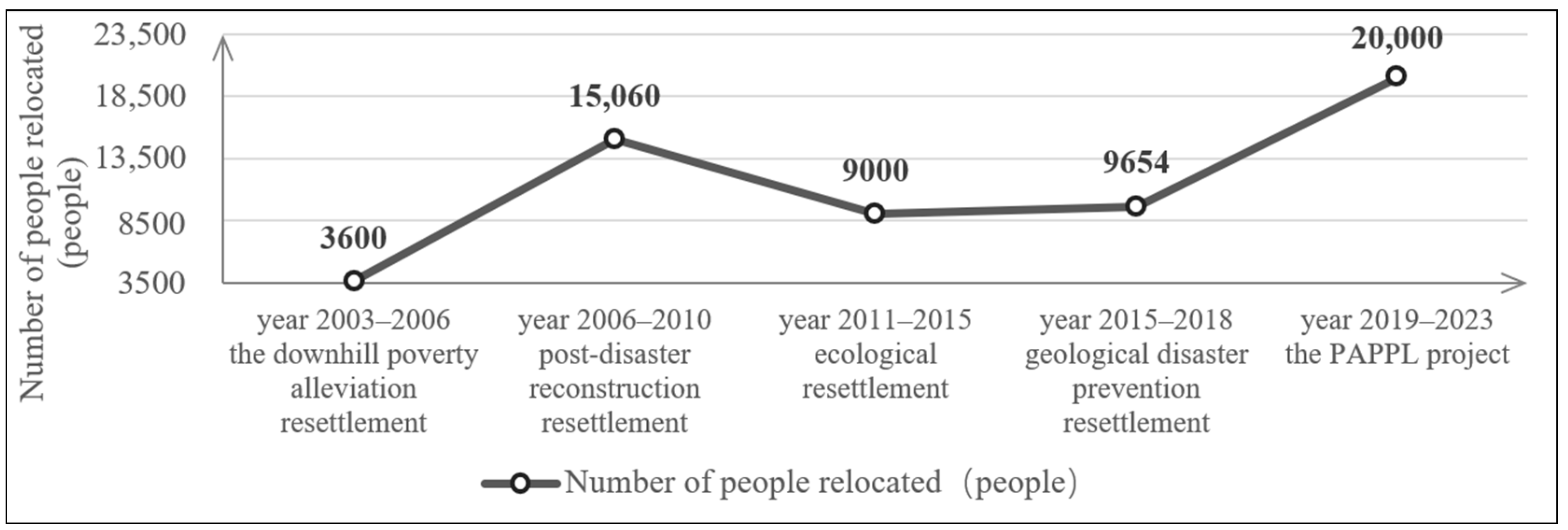
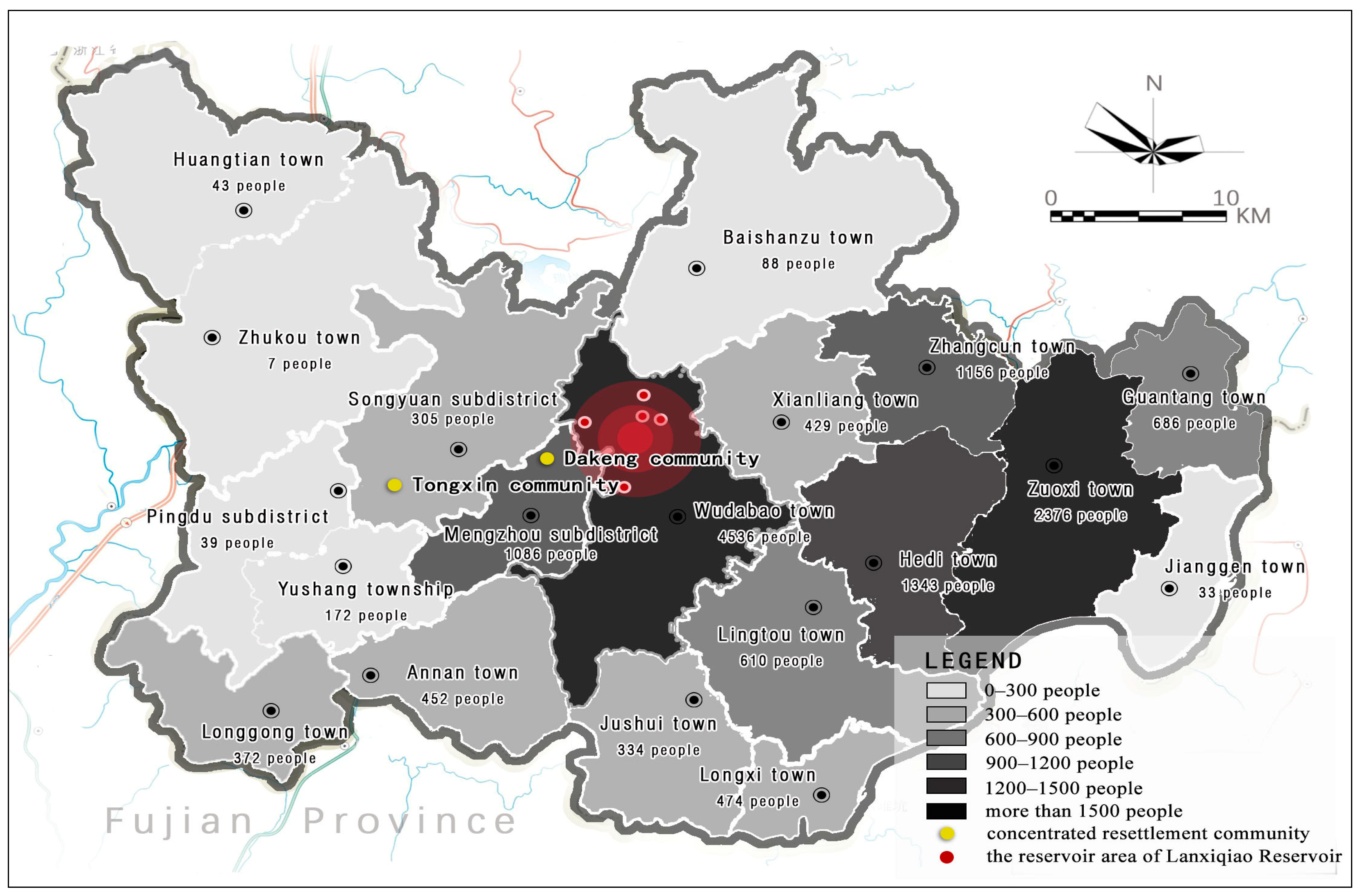


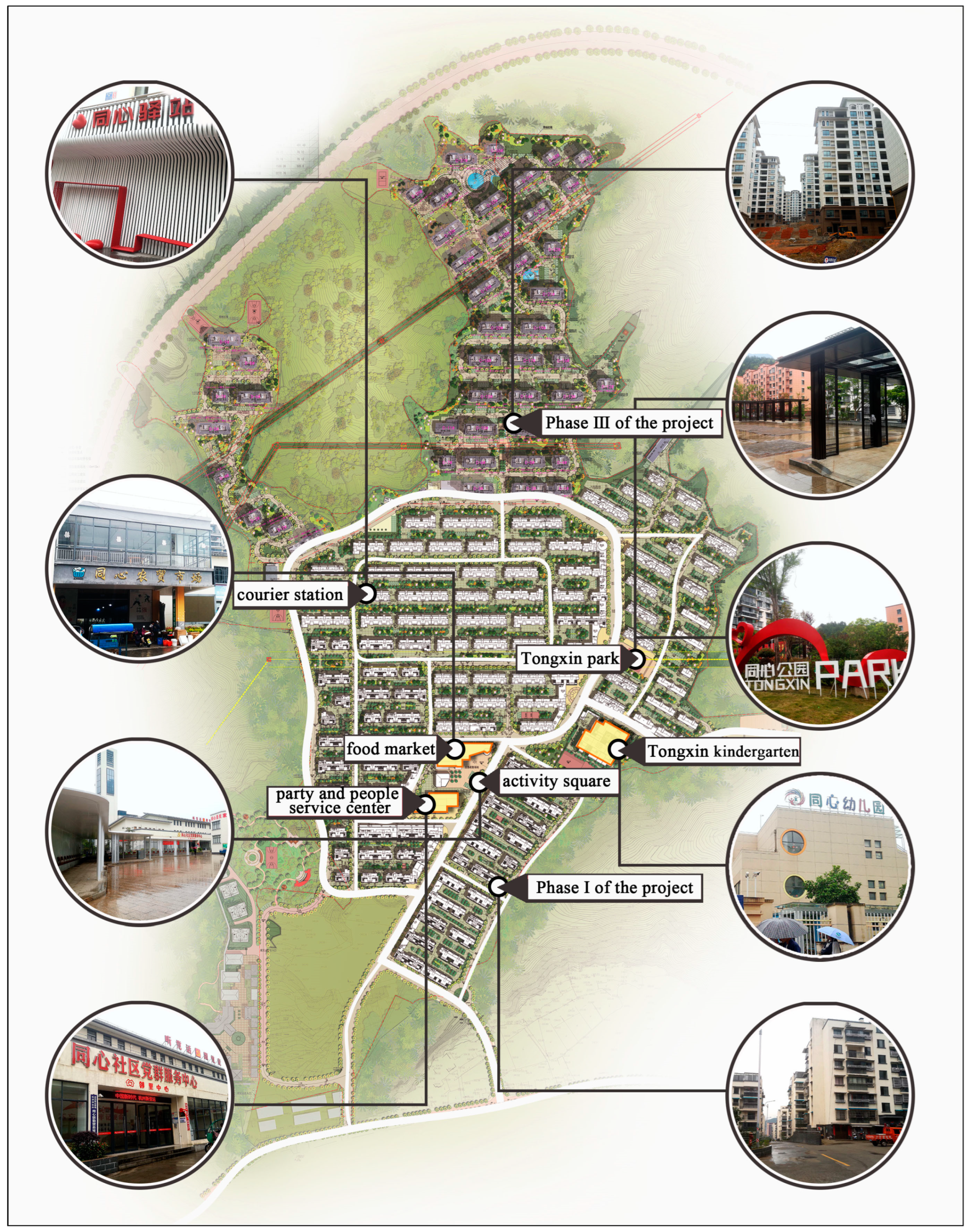



| Serial Number | Time | Interviewee | Content | Location | Form |
|---|---|---|---|---|---|
| 1 | August 2022 | A government official in charge of the resettlement | Specific progress of PAR | Online via Tencent Meeting | Online interview |
| 2 | April 2023 | A government official in charge of the resettlement | Specific progress of PAR | Zhejiang Women’s Cadre School, Xihu District, Hangzhou | Face-to-face interview |
| 3 | April 2023 | A plan-maker of Qingyuan’s 2019 resettlement planning | Zhejiang Women’s Cadre School, Xihu District, Hangzhou | Face-to-face interview | |
| 4 | May 2023 | A government official in charge of the land reclamation | Reclamation conditions of homestead | Online via Tencent Meeting | Online interview |
| 5 | May 2023 | A government official in charge of the resettlement | The impact of its implementation and its distinguishing characteristics | The resettlement functional department of Qingyuan | Face-to-face interview |
| 6 | May 2023 | A plan-maker of Qingyuan’s 2019 resettlement planning | The resettlement functional department of Qingyuan | Face-to-face interview |
| Institution | Data Collected | URL | |
|---|---|---|---|
| National level | China State Council | National PAR and ER policies | www.ndrc.gov.cn (accessed on 13 February 2023) |
| The National Rural Revitalization Administration | Rural area PAR policies | nrra.gov.cn (accessed on 13 February 2023) | |
| Provincial level | The People’s Government of Zhejiang Province | Zhejiang PAR and ER policies, announcements, statistical data | www.zj.gov.cn (accessed on 13 February 2023) |
| Zhejiang Provincial Department of Agriculture and Rural Affairs | Zhejiang rural area PAR regulations | nynct.zj.gov.cn (accessed on 13 February 2023) | |
| Department of Natural Resources of Zhejiang Province | Zhejiang land use policies | zrzyt.zj.gov.cn (accessed on 13 February 2023) | |
| Municipal and county level | The People’s Government of Lishui | Lishui PAR and ER policies and programmes | www.lishui.gov.cn (accessed on 13 February 2023) |
| The People’s Government of Qingyuan | Qingyuan PAR and ER policies and programmes, annual government work reports | www.zjqy.gov.cn (accessed on 13 February 2023) |
| Category | Resettlement Methods Documented in the Policies | Explanations | Compensation Standards |
|---|---|---|---|
| Concentrated resettlement | Concentrated resettlement | Resettlement of farmers in the government’s unified planning and construction of resettlement communities to buy apartment houses | A subsidy of CNY 30,000 per capita to low-income farmers and CNY 15,000 per capita to other non-low-income farmers [58] |
| Subsidised resettlement | The government builds a certain percentage of rent-free and low-cost housing in the resettlement communities for low-income farmers who cannot afford to buy or build houses in the village-based resettlement | A subsidy of CNY 15,000 per capita | |
| Scattered resettlement | Monetary resettlement | Resettlement of farmers to purchase their own homes or stay with relatives; once they provide proof of resettlement, they are given a disposable monetary subsidy for resettlement | One-time monetary subsidy of CNY 30,000 per capita |
| Self-built housing resettlement | Relocated farmers voluntarily apply to the nearest designated resettlement site, which grants new houses for resettlement. The area of resettlement houses is determined in accordance with the area of the homestead, which is uniformly allocated by the state [61] | A subsidy of CNY 30,000 per capita to low-income farmers and CNY 20,000 per capita to other non-low-income farmers | |
| ‘House ticket’ resettlement | Relocated farmers can purchase any commercial housing within the county with a ‘house ticket’ [62], i.e., a certificate of settlement for re-purchasing a house | A subsidy of more than CNY 60,000 per capita for the purchase of a house within a specified year | |
| Price-limited housing resettlement | Relocated farmers can purchase government-designated commercial housing with limited prices |
| Project Location | Before Land Reclamation | After Land Reclamation |
|---|---|---|
| Shichuan Village, Xianliang Township | 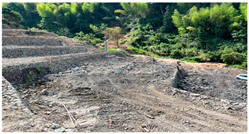 |  |
| Huangxian Village, Zuoxi Township | 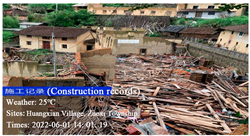 | 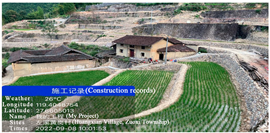 |
Disclaimer/Publisher’s Note: The statements, opinions and data contained in all publications are solely those of the individual author(s) and contributor(s) and not of MDPI and/or the editor(s). MDPI and/or the editor(s) disclaim responsibility for any injury to people or property resulting from any ideas, methods, instructions or products referred to in the content. |
© 2024 by the authors. Licensee MDPI, Basel, Switzerland. This article is an open access article distributed under the terms and conditions of the Creative Commons Attribution (CC BY) license (https://creativecommons.org/licenses/by/4.0/).
Share and Cite
Cao, K.; Yang, R.; Zhu, P.; Zhang, X.; Zhai, K.; Gao, X. Understanding the Sustainable Mechanisms of Poverty Alleviation Resettlement in China’s Developed Regions under the Background of Land Relocation: Drivers, Paths and Outcomes. Land 2024, 13, 380. https://doi.org/10.3390/land13030380
Cao K, Yang R, Zhu P, Zhang X, Zhai K, Gao X. Understanding the Sustainable Mechanisms of Poverty Alleviation Resettlement in China’s Developed Regions under the Background of Land Relocation: Drivers, Paths and Outcomes. Land. 2024; 13(3):380. https://doi.org/10.3390/land13030380
Chicago/Turabian StyleCao, Kang, Ronglu Yang, Pengyu Zhu, Xingman Zhang, Keyu Zhai, and Xing Gao. 2024. "Understanding the Sustainable Mechanisms of Poverty Alleviation Resettlement in China’s Developed Regions under the Background of Land Relocation: Drivers, Paths and Outcomes" Land 13, no. 3: 380. https://doi.org/10.3390/land13030380
APA StyleCao, K., Yang, R., Zhu, P., Zhang, X., Zhai, K., & Gao, X. (2024). Understanding the Sustainable Mechanisms of Poverty Alleviation Resettlement in China’s Developed Regions under the Background of Land Relocation: Drivers, Paths and Outcomes. Land, 13(3), 380. https://doi.org/10.3390/land13030380






